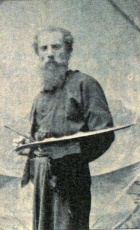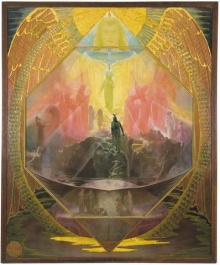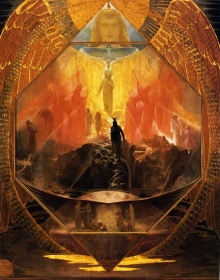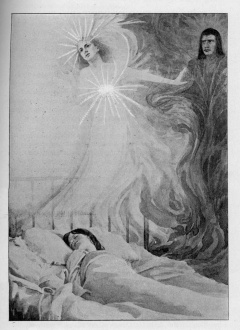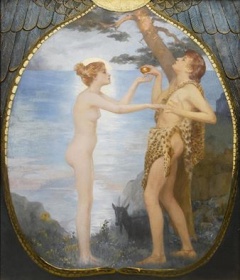Reginald Machell: Difference between revisions
No edit summary |
|||
| Line 1: | Line 1: | ||
[[File:Reginald Machell.jpg|140px| | [[File:Reginald Machell.jpg|140px|right|thumb|Reginald Machell September 1897 in ''Theosophy''.]] | ||
[[File:Reginald Machell The Path.jpg|220px|right|thumb|''The Path'']] | [[File:Reginald Machell The Path.jpg|220px|right|thumb|''The Path'']] | ||
[[File:Machell The Path 2.jpg|right|220px|thumb|''The Path'']] | |||
Reginald Willoughby Machell (1854-1927) was an English painter whose best-known work is [[The Path (art work)|''The Path'']]. After he met [[ | Reginald Willoughby Machell (1854-1927) was an English painter whose best-known work is '''[[The Path (art work)|''The Path'']]''' on January 12, 1888. After he met [[Helena Petrovna Blavatsky]] in London, he joined the [[Theosophical Society]]. A few years later he moved to California and lived at [[Point Loma]], where he painted, wrote, and designed furniture. | ||
== Early years and education == | == Early years and education == | ||
Reginald Machell was born in Crackenthorpe, Westmorland, England, in 1854. During his education at Uppingham School and at Owens College, he was awarded many prizes for his drawing and for his study of the classics. He married Ada Mary Simpson in 1875. That same year, he traveled to London to continue study, and the next year attended the Académie Julien in Paris.<ref>Bruce Kamerling, “Theosophy and Symbolist Art: the Point Loma Art School,” ''The Journal of San Diego History'' 26:4 (Fall 1980).[http://www.sandiegohistory.org/journal/80fall/theosophy.htm]</ref> | |||
== Theosophical Society == | == Theosophical Society == | ||
| Line 23: | Line 23: | ||
</blockquote> | </blockquote> | ||
=== The Path === | |||
Among Theosophists, Machell is noted for his painting, [[The Path (art work)|''The Path'']] (6’2” x 7’5”), which is at the headquarters of the Theosophical Society, in Pasadena, California. Machell also constructed the frame for the painting in ornately carved woodwork. | |||
=== Furniture, crafts, and decoration === | |||
His creativity in furniture making was noteworthy: | His creativity in furniture making was noteworthy: | ||
<blockquote> | <blockquote> | ||
At Point Loma, he carved chairs, screens and stools decorated with forms reminiscent of Art Nouveau, Celtic interlace, Gothic tracery, flames and wings. They are wonderfully inventive, completely unlike any other furniture made in America. The throne he created for Tingley is typical: the back and sides of the chair are carved into fantastic writhing shapes and the whole is painted in a cream color. In effect, the chair is a platform for a collection of carved panels, a virtuoso display of design and chisel-work. But it’s not a great example of sound construction: the joints are held together with pegs, which are notoriously prone to coming loose. As for the symbolism of the intertwining elements of the disk and the winglike forms above, it’s anybody’s guess. Machell left no explanation<ref>Janet Koplos and Bruce Metcalf, "Reginald Machell at Point Loma," excerpt from ''Makers: A History of American Studio Craft'', University of North Carolina Press, 2010. Available from the | At Point Loma, he carved chairs, screens and stools decorated with forms reminiscent of Art Nouveau, Celtic interlace, Gothic tracery, flames and wings. They are wonderfully inventive, completely unlike any other furniture made in America. The throne he created for Tingley is typical: the back and sides of the chair are carved into fantastic writhing shapes and the whole is painted in a cream color. In effect, the chair is a platform for a collection of carved panels, a virtuoso display of design and chisel-work. But it’s not a great example of sound construction: the joints are held together with pegs, which are notoriously prone to coming loose. As for the symbolism of the intertwining elements of the disk and the winglike forms above, it’s anybody’s guess. Machell left no explanation<ref>Janet Koplos and Bruce Metcalf, "Reginald Machell at Point Loma," excerpt from ''Makers: A History of American Studio Craft'', University of North Carolina Press, 2010. Available from the | ||
[http://www.americanstudiocrafthistory.org/chapterResources/Ch_2_ReginaldMachell.pdf]</ref> | [http://www.americanstudiocrafthistory.org/chapterResources/Ch_2_ReginaldMachell.pdf Center for Craft, Creativity and Design.]</ref> | ||
</blockquote> | </blockquote> | ||
=== Exhibits === | |||
[[File:Adam and Eve.jpg|right|240px|thumb|Adam and Eve.]] | [[File:Adam and Eve.jpg|right|240px|thumb|Adam and Eve.]] | ||
His work was exhibited at the Panama California Exposition in San Diego in 1915, along with that of three other Point Loma artists - Leonard Lester, Maurice Braun, and Edith White.<ref>Bruce Kamerling, “Theosophy and Symbolist Art: the Point Loma Art School,” ''The Journal of San Diego History'' 26:4 (Fall 1980). Available at [http://www.sandiegohistory.org/journal/80fall/theosophy.htm San Diego History website.]</ref> | |||
His work was exhibited at the Panama California Exposition in San Diego in 1915, along with that of three other Point Loma artists - Leonard Lester, Maurice Braun, and Edith White.<ref>Bruce Kamerling, “Theosophy and Symbolist Art: the Point Loma Art School,” ''The Journal of San Diego History'' 26:4 (Fall 1980).[http://www.sandiegohistory.org/journal/80fall/theosophy.htm]</ref> | |||
== Writings == | == Writings == | ||
Mr. Machell contributed | According to the [[Union Index of Theosophical Periodicals]], Mr. Machell contributed at least [http://www.austheos.org.au/cgi-bin/ui-csvsearch.pl?search=Reginald+Machell&method=all 38 articles] and also illustrations to Theosophical periodicals, principally [[Lucifer (periodical)|''Lucifer'']], [[Theosophy (periodical)|''Theosophy'']], [[The Path (periodical)|''The Path'']], and [[Sunrise (periodical)|''Sunrise'']]. The newest magazine to use ''The Path'' is ''Lotus'', published by the Pandacan Theosophical Society in The Philippines. | ||
== Later years == | == Later years == | ||
| Line 54: | Line 59: | ||
[[Category:Associates of HPB|Machell, Reginald]] | [[Category:Associates of HPB|Machell, Reginald]] | ||
[[Category:Nationality English|Machell, Reginald]] | [[Category:Nationality English|Machell, Reginald]] | ||
[[Category:People|Machell, Reginald]] | |||
Revision as of 19:08, 6 November 2017
Reginald Willoughby Machell (1854-1927) was an English painter whose best-known work is The Path on January 12, 1888. After he met Helena Petrovna Blavatsky in London, he joined the Theosophical Society. A few years later he moved to California and lived at Point Loma, where he painted, wrote, and designed furniture.
Early years and education
Reginald Machell was born in Crackenthorpe, Westmorland, England, in 1854. During his education at Uppingham School and at Owens College, he was awarded many prizes for his drawing and for his study of the classics. He married Ada Mary Simpson in 1875. That same year, he traveled to London to continue study, and the next year attended the Académie Julien in Paris.[1]
Theosophical Society
Machell had the opportunity to meet H. P. Blavatsky:
In 1887, through a friend of one of his aunts, Machell was introduced to Theosophy and eventually to Helena Blavatsky herself. Machell joined the Theosophical Society and in 1890 did some interior decoration in Blavatsky's Regents Park residence. He later moved his studio to the same building and the character of his work began to change toward mysticism and symbolism.[2]
Artistic career
Machell took up a career in 1880 as a portrait painter. He became was a member of the Royal Society of British Artists, and exhibited at the Royal Academy. He illustrated two works by American novelist Irene Osgood. An Idol's Passion was a novel of "Oriental romance" dealing with the paranormal, published in a large and lavish folio edition. The Chant of the Lonely Soul was published the following year.[3]
Leaving for Point Loma in 1900 with his son Montague, Machell arrived on December 28 in the same party as Charles J. Ryan. Machell became actively involved with the decoration of the Lomaland buildings including architectural ornamentation, painted wall designs, and carved furniture and screens. He also carved his own frames which became an integral part of his paintings. Machell was a prolific writer and illustrator for the periodical publications on Point Loma as well as books such as Kenneth Morris' The Fates of the Princes of Dyfed (1914). He also frequently took part in the many dramatic productions including being appropriately cast as Phidias in "The Aroma of Athens." Machell's work is mystical in the extreme and certainly the most didactic of any of the Lomaland artists. It combines both Pre-Raphaelite and Art Nouveau stylistic tendencies. The whip-lash line and entwined tendrils typical of the Art Nouveau style are particularly evident in his wood carving.[4]
The Path
Among Theosophists, Machell is noted for his painting, The Path (6’2” x 7’5”), which is at the headquarters of the Theosophical Society, in Pasadena, California. Machell also constructed the frame for the painting in ornately carved woodwork.
Furniture, crafts, and decoration
His creativity in furniture making was noteworthy:
At Point Loma, he carved chairs, screens and stools decorated with forms reminiscent of Art Nouveau, Celtic interlace, Gothic tracery, flames and wings. They are wonderfully inventive, completely unlike any other furniture made in America. The throne he created for Tingley is typical: the back and sides of the chair are carved into fantastic writhing shapes and the whole is painted in a cream color. In effect, the chair is a platform for a collection of carved panels, a virtuoso display of design and chisel-work. But it’s not a great example of sound construction: the joints are held together with pegs, which are notoriously prone to coming loose. As for the symbolism of the intertwining elements of the disk and the winglike forms above, it’s anybody’s guess. Machell left no explanation[5]
Exhibits
His work was exhibited at the Panama California Exposition in San Diego in 1915, along with that of three other Point Loma artists - Leonard Lester, Maurice Braun, and Edith White.[6]
Writings
According to the Union Index of Theosophical Periodicals, Mr. Machell contributed at least 38 articles and also illustrations to Theosophical periodicals, principally Lucifer, Theosophy, The Path, and Sunrise. The newest magazine to use The Path is Lotus, published by the Pandacan Theosophical Society in The Philippines.
Later years
Machell died in San Diego on October 8, 1927.
Additional resources
- L. A. "Reginald Willoughby Machell (1854 – 1927)" at American Gallery website. A gallery of Machell paintings posted in a blog.
- Some of Machell's other paintings can be viewed at a BBC (British Broadcasting Company) web page.[4]
Notes
- ↑ Bruce Kamerling, “Theosophy and Symbolist Art: the Point Loma Art School,” The Journal of San Diego History 26:4 (Fall 1980).[1]
- ↑ Bruce Kamerling, “Theosophy and Symbolist Art: the Point Loma Art School,” The Journal of San Diego History 26:4 (Fall 1980).[2]
- ↑ An Idol's Passion. New York and London: The Transatlantic Publishing Company, 1895.
- ↑ Bruce Kamerling, “Theosophy and Symbolist Art: the Point Loma Art School,” The Journal of San Diego History 26:4 (Fall 1980).[3]
- ↑ Janet Koplos and Bruce Metcalf, "Reginald Machell at Point Loma," excerpt from Makers: A History of American Studio Craft, University of North Carolina Press, 2010. Available from the Center for Craft, Creativity and Design.
- ↑ Bruce Kamerling, “Theosophy and Symbolist Art: the Point Loma Art School,” The Journal of San Diego History 26:4 (Fall 1980). Available at San Diego History website.
